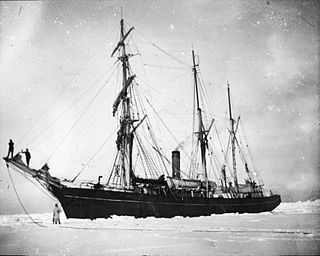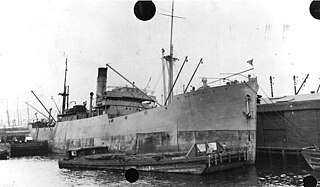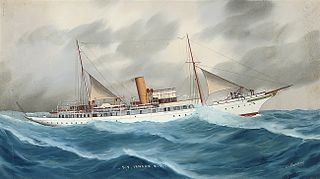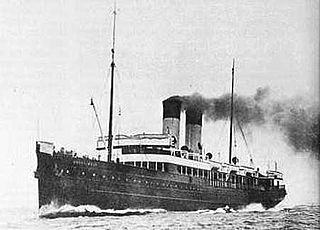
Nimrod was a wooden-hulled, three-masted sailing ship with auxiliary steam engine that was built in Scotland in 1867 as a whaler. She was the ship with which Ernest Shackleton made his Nimrod Expedition to Antarctica in 1908–09. After the expedition she returned to commercial service, and in 1919 she was wrecked in the North Sea with the loss of ten members of her crew.

Christopher Furness, 1st Baron Furness was a British businessman and Liberal Party politician.

Jun'yō Maru (順陽丸) was a cargo steamship that was built in Scotland in 1913, served a succession of British owners until 1927, and was then in Japanese ownership until a Royal Navy submarine sank her in 1944.
SS Vadala was a cargo steamship that was launched in Scotland in 1890, renamed Kenkon Maru No. 12 in 1913, and sank as the result of a collision in 1928. She was built for the British India Steam Navigation Company (BI). In 1895 she took Indian indentured labourers to Fiji. In 1899 was a troop ship in the Second Boer War. From 1913 she was in Japanese ownership.
SS Wardha was a merchant steamship that was built in Scotland in the 1880s and scrapped in Italy in 1923. She was one of a pair of sister ships that were designed to carry cotton, but completed for the British India Steam Navigation Company (BI) to carry sugar. In 1899 she carried troops and cavalry horses for the Second Boer War. In the 1900s she took Indian indentured labourers to British Guiana and Fiji. From 1913 onward she passed through a succession of Italian owners, but kept her original name.
SS Mulbera was a British India Steam Navigation Company (BI) turbine steamship that was built in 1922 and scrapped in 1954. She belonged to BI's "M" class of cargo liners. She was the last member of the class to be built, and the last to survive in service.

SS Statendam was a transatlantic ocean liner that was launched in Ireland in 1898 for Holland America Line. She was the first of several ships in the company's history to be called Statendam. She was NASM's first ship of more than 10,000 GRT, and she was the largest ship in the company's fleet until Potsdam was completed in 1900.

USS Charlton Hall (ID-1359) was a cargo steamship that was built in Scotland in 1907 and served in the merchant fleets of the United Kingdom, United States and Greece. She served in the United States Navy in 1918. She was renamed Atlantis and then Anastasis in 1930. She was scrapped in China in 1934.

USS Craster Hall (ID-1486) was a cargo steamship that was built in Scotland in 1909 and served in the merchant fleets of first the United Kingdom and then the United States. From 1918 to 1919, she served in the United States Navy. In 1927, she was damaged in a collision off the coast of Peru, was beached to prevent her sinking, but was wrecked.

USS Remlik (SP-157) was a steam yacht that was built in England in 1903 as Candace. She was renamed Remlik in 1907 when she changed owners. She was converted into a United States Navy patrol boat in 1917 and served in the First World War. She was decommissioned in 1919, converted into a commercial craft in 1920, and scuttled in 1932.

James Cleland Burns, 3rd Baron Inverclyde, was the second son of John Burns, the first Lord Inverclyde, and grandson of Sir George Burns, 1st Baronet, a founder of the Cunard Line. James Burns succeeded to the title of Baron Inverclyde on the death of his elder brother, George Burns, in 1905.

SMS Leopard was a British cargo steamship that was built in 1912 as Yarrowdale, captured in 1916 by the Imperial German Navy, converted into a commerce raider in Germany, and sunk with all hands by the Royal Navy in 1917.

HMS Warrior was a steel-hulled steam yacht that was launched in Scotland in 1904. Her first owner was Frederick William Vanderbilt. One of his cousins, Alfred Gwynne Vanderbilt, owned her for a few months before he was killed in the sinking of RMS Lusitania. She passed through several owners. She was renamed Wayfarer in 1914, Warrior again in 1915, Goizeko-Izarra in 1920, Warrior again in 1937, and Warrior II in 1939. She was commissioned into the Royal Navy in both world wars, and evacuated Republican child refugees in the Spanish Civil War.

SS Waroonga was a steel-hulled passenger and cargo steamship that was launched in Scotland in 1882, renamed Bansei Maru in 1913 and scrapped in Japan in 1926. Her career included periods in British, Australian and Japanese ownership.

TS Vanadis was a steel-hulled steam yacht that was launched in Scotland in 1908. When new, she was said to be one of the largest steam yachts in the World. She was renamed Poryv in 1917, Finlandia in 1919, and Ianara in 1925. She was one of very few steam yachts propelled by direct-drive steam turbines instead of reciprocating engines. In 1910 her high-pressure turbine was replaced with a triple-expansion engine, in order to reduce her excessive coal consumption. She was owned in the United States until 1917, when she became a ship of the Imperial Russian Navy. After the First World War, she passed through a succession of Finnish, French, and United Kingdom owners. She was scrapped in Italy in 1936.

White Ladye was a steel-hulled steam yacht. She was launched in Scotland in 1891 as Ladye Mabel, and renamed White Ladye by 1893. By 1919 she had been converted into a steam fishing trawler, and renamed La Champagne. She was built for Francis Baring, 5th Baron Ashburton. By 1893 she belonged to the actress Lillie Langtry. From 1893 the US businessman Ogden Goelet regularly chartered her. By 1900 John Lawson Johnston, the creator of Bovril, owned her. By 1902 William Cresswell Gray, of shipbuilders William Gray & Company, owned her. By 1919 Jérome Malandain of Fécamp owned her, and was using her as a trawler. She was laid up from 1926, and scrapped in Belgium in 1935.

SS Copenhagen was a North Sea passenger ferry that was built in Scotland in 1907. She was the Great Eastern Railway (GER)'s first turbine steamship. In 1916 she was requisitioned as an ambulance ship. A U-boat sank her in 1917 with the loss of six lives.

SS Munich was a North Sea passenger ferry that was built in Scotland in 1908 for the Great Eastern Railway (GER). In the 1923 railway grouping she passed to the new London and North Eastern Railway (LNER). She was scrapped in England in 1950.

HMS Tuscarora was a steam yacht that was launched in Scotland in 1897 as Tuscarora. In 1911 she was renamed Goizeko-Izarra, and in 1922 her name was changed back to Tuscarora. In 1940 the Admiralty requisitioned her; had her converted into an anti-submarine training ship; and commissioned her as HMS Tuscarora. She spent the war based at Campbeltown on the west coast of Scotland. In 1946 the Ministry of Transport sold her, and she was converted into a merchant ship. She was renamed Anatoli in 1946, Evgenia in 1952, and Alhelal in 1968. She sank in the Red Sea in 1968.
SS Manchester City was a British cargo steamship that was built in Glasgow in 1937 and scrapped in Faslane in 1964. The Royal Navy requisitioned her in the Second World War.















